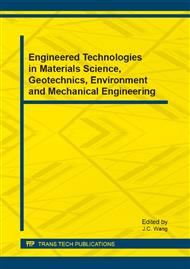[1]
J.H. Chen, The combined use of chemical and organic fertilizer and/or bio-fertilizer for crop growth and soil fertility, International workshop on sustained management of the soil-Rhizophere system for efficient crop production and fertilizer use, 2006.
DOI: 10.1007/978-94-011-3224-4_12
Google Scholar
[2]
G. Jung, J. Mugnier, H.G. Diem, Y.R. Dommergues, Polymer-entrapped Rhizobium as an inoculant for legumes, Plant Soil. 65 (1982) 219-231.
DOI: 10.1007/bf02374652
Google Scholar
[3]
A. Sessitsch, P.K. Jjempa, G. Hardarson, A.D.L. Akkermans, K.J. Wilson, Measurement of the competitive index of Rhizobium Tropici strain CIAT899 derivatives marked with the GusA gene, Soil Biochem. 39 (1998) 1099-1110.
DOI: 10.1016/s0038-0717(97)00002-3
Google Scholar
[4]
J. Blazquez, Hypermutation as a factor contributing to the acquisition of antimicrobial resistance, Clin. Infect. Dis. 37 (2003) 1201-1209.
DOI: 10.1086/378810
Google Scholar
[5]
A. Couce, J. Blazquez, Side effects of antibiotics on genetic variability, FEMS microbial Rev. 33 (2009) 531-538.
DOI: 10.1111/j.1574-6976.2009.00165.x
Google Scholar
[6]
B.F. Brehm-Stecher, E.A. Johnson, Sensitization of Staphylococcus aureus and Escherichia coli to antibiotics by the sesquiterpenoids nerolidol, farnesol, bisabolol, and apritone, Antimicrob. Agents. Ch. 47 (2003) 2257-3360.
DOI: 10.1128/aac.47.10.3357-3360.2003
Google Scholar
[7]
E. Rossland, T. Langsrud, T. Sorhaug, Influence of controlled lactic fermentation on growth and sporulation of Bacillus cereus in milk, Int. J. Food Microbiol. 103 (2005) 69-77.
DOI: 10.1016/j.ijfoodmicro.2004.11.027
Google Scholar
[8]
R. Paduch, G. Matysik, M. Wojciak-Kosior, M. Kandefer-Szerszen, A. Skalska- Kaminska, M. Nowak-Kryska, P. Niedziela, Lamium Album extracts express free radical scavenging and cytotoxic activities, Pol. J. Environ. Stud. 17 (2008) 569-580.
Google Scholar
[9]
Y. Lu, Y.P. Zhao, Z.C. Wang, S.Y. Chen, C.X. Fu, Composition and antimicrobial activity of the essential oil of Actinidia macrosperma from China, Nat. Prod. Res. 21 (2007) 227-233.
DOI: 10.1080/14786410601132311
Google Scholar
[10]
K. Lewis, F.M. Ausubel, Prospects for plant-derived antibacterials, Nat. Biotechnol. 24 (2006) 1504-1507.
DOI: 10.1038/nbt1206-1504
Google Scholar
[11]
H.O. Edeoga, D.E. Okwu, B.O. Mbaebie, Phytochmical constituents of some Nigerian medicinal plants, Afr. J. Biotechnol. 4 (2005) 685-688.
DOI: 10.5897/ajb2005.000-3127
Google Scholar
[12]
R. Nawrot, K. Lesniewicz, J. Pienkowska, A, Gozdzicka-Jozefiak, A novel extracellular peroxidase and nucleases from a milky sap of Chelidonium majus, Fitoterapia. 78(2007) 496-501.
DOI: 10.1016/j.fitote.2007.04.012
Google Scholar
[13]
P.E. Olsen, W.A. Rice, M.M. Collins, Biological contaminants in north American legume inoculants, Soil Biol. Biochem. 27 (1994) 699-701.
DOI: 10.1016/0038-0717(95)98650-d
Google Scholar
[14]
M. Li, M. Alexander, Co-inoculation with antibiotic producing bacteria to increase colonization and nodulation by rhizobia, Plant Soil. 108 (1988) 211-219.
DOI: 10.1007/bf02375651
Google Scholar
[15]
B.Y. Wei, L.Z. He, S.Q. Gong, J.L. Li, A new method to selecting dye- decolorizing bacteria-decolorizing circle, Hunan Agri. Sci. 1 (2010) 10-12. (in Chinese)
Google Scholar
[16]
X.Y. Yang, B.G. Zhao, Y.W. Ju, Antifungal activities and synergetic tests of matrine and oxymatrine to some tree pathogens, J. Nanjing Forestry University, 32 (2008) 70-82. (in Chinese)
Google Scholar
[17]
A.J. Zhang, C.F. Zhang, X.Q. Wang, F.Q. Yang, J. Chen, T. Li, In vitro inhibitory effect of matrine and oxymatrine, J. Ningxia Medical University, 33 (2011) 855-856.
Google Scholar
[18]
X.H. Yi, Z.H. Wang, L.F. Hu, X.M. Liu, J.T. Feng, X. Zhang, Isolation of endophytic fungal in Pyrehtrum cineraria folium Trev. and the screening of their antifungal activity, Acta Bot. Boreal- Occident. Sin. 28 (2008) 0317-0323.
Google Scholar


